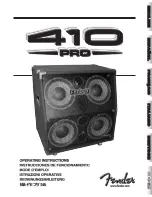
5
Replacing Tubes,
Service and
preventive Maintenance
TRILOGY™ is factory-loaded with EL34 and 12AX7 tubes.
Once they’ve been burned in – that is, operated continuously
under a load – they are subjected to a rigorous selection process.
Their electrical specs and mechanical status (microphonics) are
checked, and then they are installed in an amp and sound-
checked. One of the most important steps in this process is
tube matching, whereby tubes with the same characteristics
are teamed up in matched sets of power tubes.
5.1 When to Replace Tubes
The tubes in TRILOGY™ are exemplary in terms of quality,
workmanship and long service life. In the unlikely event that
you encounter a problem, please run down the following
checklist before you swap your old tubes for a new set:
Was the fault or failure of the power tube caused by the tube
itself or by a flawed peripheral device or component, perhaps
a defective speaker cable? (If you don’t get to the bottom of
the problem and remedy it, it may crop up again even after
you replace the tubes.)
Did the mains voltage fluctuate or spike while the amp was
on? In all-tube amps, over-voltage surges in the mains net can
certainly cause drop-outs. Over-voltages are often caused by
generators and faulty high-current power circuits. Perhaps a
fuse blew even though none of the tubes is actually defective?
An old fuse, tube de-ionization or mains voltage power surges
may have triggered the fuse. In this case, replacing tubes is a
waste of money, time and effort.
Tubes show definite signs of wear when their service life is
nearing its end. Telltale signs are increased microphonics, noise
and hiss, muddier tone through loss of high-end frequencies,
degraded performance, etc. Take these indications seriously
and replace old tubes. Not only do these side effects take their
toll on sound quality, they also indicate the aging tube will
soon fail!
x
Note:
Replacing tubes for experimentation purposes is not recom-
mended. Installing the wrong tubes will damage the amp and
cost you a lot more than you bargained for in repair costs.
5.2 Things to Bear in Mind When Replacing Tubes
The golden rule is that replacing tubes is a job best left to
qualified professionals. Accordingly, the following guidelines
are addressed and apply to qualified service technicians only:
Pull TRILOGY™’s mains plug and allow for a discharge time of
at least two minutes before removing the chassis from the rear
of the amp. Once the chassis has been removed, carefully ease
the tubes out of their sockets. A single power tube may only
be replaced if the replacement tube precisely matches the
original, that is, the old and new tubes’ characteristics are
identical. As a rule, use matched sets only when replacing
power tubes. When a new set of power tubes with characteristics
identical to the old set is installed, it is not absolutely necessary
to re-bias the amp. However, the amp must be biased when
a replacements set’s characteristics do not match the original
set’s. This requires experience and extensive working know-
ledge in measuring techniques, which is why this is a job for
qualified technicians with tube amp tuning experience.
5.3 How to Prolong Tube Life
• Never operate Trilogy™ without connecting a load (loud-
speaker)! To this end, always use high-quality, heavy-duty
speaker cords that won’t crimp.
• Use the STANDBY switch! Heating up tubes frequently shortens
tube life. Cut anode voltage using the STANDBY function to
decrease operating hours and extend tube life.
• Avoid exposing the amp to vibrations, especially when it’s
powered up. Switch the amp off well before transporting it
to allow tubes to cool off completely.
• Make sure all peripheral devices and connecting cords are in
a state of good repair! Ensure air can circulate freely around
the amp’s ventilation slots at all timesæyour Trilogy™’s life
depends on it.
• Never expose the amp to extreme heat, heavy dust and, par-
ticularly, moisture.
• Always check peripheral gear’s specs to ensure these
accessories are suitable for the amp. Never connect speaker
cabinets with an impedance (ohm) rating lower than
Trilogy™ is designed to handle.
• Never connect devices with high output signal levels (e.g.
power amps) to Trilogy™’s input.
• Check the mains power rating before plugging the amp in.
When in doubt ask the venue’s sound technician or facility
engineer.
• Refrain from DIY repairs! Also have a qualified technician
replace internal fuses.
Trilogy™ Manual 1.1
10











































